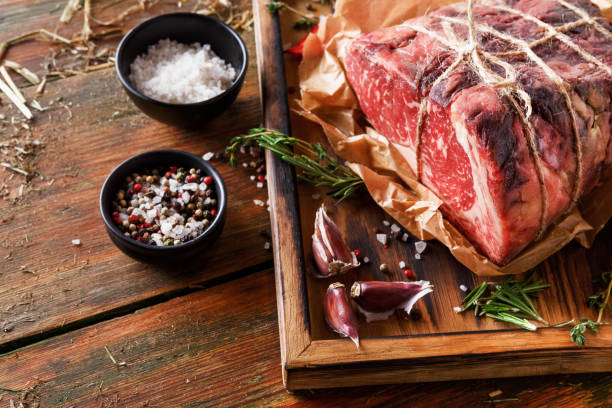There’s a reason why a perfectly aged steak is the crown jewel of many upscale restaurant menus. The process of aging beef transforms it from a good cut to a sublime, melt-in-your-mouth culinary experience. If you’ve ever wondered what goes into creating those rich, flavorful, and tender steaks, this article will have all the answers you’re looking for.
1. The Basics of Steak Aging
Steak aging is a controlled process that involves storing cuts of beef under precise conditions. There are two primary methods:
- Dry Aging: This method involves placing beef cuts in a humidity-controlled environment for several weeks. During the aging process, moisture evaporates from the meat, concentrating the flavors. The natural enzymes in the beef also break down muscle fibers, resulting in a tender and intensely flavored steak.
- Wet Aging: Wet aging, as the name suggests, involves vacuum-sealing beef cuts in plastic bags. While not as intense as dry aging, this method still allows for flavor enhancement and tenderness over time. Wet-aged steaks tend to retain more moisture.
2. Choosing the Right Cut
The type of steak cut plays a significant role in the aging process. Some cuts are better suited for aging than others. Here are a few popular choices:
- Ribeye: Ribeye steaks are renowned for their marbling, making them ideal candidates for aging. The abundant fat within the meat enhances both flavor and tenderness.
- Sirloin: Sirloin cuts are known for their leaner profile but can still benefit from aging. The process helps break down tough fibers and intensify the taste.
- T-Bone and Porterhouse: These cuts combine two steaks in one—the tenderloin and the New York strip. Their thicker nature allows for extended aging, resulting in a remarkable flavor.
3. The Aging Period
The duration of aging varies depending on the desired outcome and the chosen method:
- Short Aging (2-3 weeks): This is ideal for those who prefer a more subtle enhancement in flavor and tenderness. Short aging works well for those who are just starting to explore the world of aged steaks.
- Medium Aging (4-6 weeks): Steaks aged for this duration begin to exhibit more pronounced flavor and tenderness. It’s a popular choice for those who want a balanced aged steak.
- Long Aging (8 weeks or more): Long aging is reserved for those who seek an intensely rich and tender steak. These steaks develop a complex, almost nutty flavor, and their tenderness is unparalleled.
4. The Role of Temperature and Humidity
Both temperature and humidity control are crucial in the aging process. In dry aging, the meat is typically stored at temperatures just above freezing (34-38°F or 1-3°C) and humidity levels around 85-90%. In contrast, wet aging requires refrigeration at a slightly higher temperature, typically around 32-34°F (0-1°C).
5. The Flavor Transformation
Aged steaks undergo a remarkable transformation in flavor. The breakdown of muscle fibers and the concentration of flavor compounds result in a steak that’s more intense, nuttier, and often described as having a “funky” or “umami” taste. While it may take a bit of adjustment for your palate to fully appreciate the difference, most steak enthusiasts find it an absolute delight.
6. Preparing and Grilling Aged Steaks
Once you’ve selected the perfect aged steak, the next step is to prepare and grill it to perfection. Here are some key tips:
- Bring the Steak to Room Temperature: Allow the steak to sit at room temperature for about 30 minutes before grilling. This ensures even cooking.
- Season Simply: Aged steaks shine with minimal seasoning. A generous sprinkle of sea salt and freshly ground black pepper is often all you need.
- Use High Heat: Preheat your grill or pan to high heat. Sear the steak for a few minutes on each side to create a flavorful crust.
- Rest Before Slicing: Allow the steak to rest for a few minutes after grilling. This allows the juices to redistribute, resulting in a more succulent steak.
- Slicing Technique: When slicing an aged steak, cut against the grain to maintain tenderness.
7. Pairing with the Right Wine
A perfectly aged steak deserves an equally exceptional wine pairing. Opt for a robust red wine like a Cabernet Sauvignon, Malbec, or Syrah. These wines complement the rich flavors of the steak and enhance the overall dining experience.
8. Savoring the Moment
Finally, when your perfectly aged steak is cooked to perfection, take your time savoring each bite. Close your eyes, appreciate the enhanced flavors, and relish the extraordinary journey from the aging room to your plate.
9. The Art of Homemade Dry Aging
While professional dry aging requires specialized equipment, you can experiment with dry aging at home using a dedicated dry-aging fridge or by creating a DIY dry-aging setup. It’s a rewarding culinary adventure for enthusiasts who want to explore the process further.
10. Beyond the Grill: Creative Steak Dishes
Aged steaks are incredibly versatile and can be used in a variety of dishes beyond traditional grilling. Explore recipes for steak au poivre, steak sandwiches, and steak salads to fully appreciate the range of culinary possibilities.

